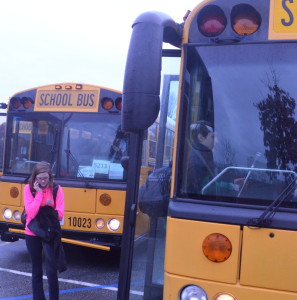Cameras Installed on School Buses
February 27, 2014

In an effort to decrease the number of drivers who illegally cut around school buses, Montgomery County officials have equipped several buses with cameras since the start of January.
If a driver is caught on camera driving around a school bus with the red stop sign extended and flashing, he or she will face a fine of $125. That fine is far lower than the charge if a driver is caught by police: $570 and three points on his or her license.
Todd Watkins, MCPS Director of Transportation, oversees all of the buses in the county. For the past three years, the county has participated in a nationwide one-day survey to see how many times cars pass buses.
“We’ve averaged being passed 1,200 times in a single day,” Watkins said. “We run just about 1,200 buses a day, so that’s an average of one per bus per day.”
State law requires drivers to stop when a school bus stops and extends its flashing stop sign. All drivers traveling in the same direction as the bus – or the opposite direction if there is no median – must stop.
Assistant Principal Bradley Rohner believes that the devices people have in their cars nowadays can distract drivers from paying attention to stopped buses.
“I watch cars fly by the buses. You’ve got the GPS going, you’ve got the radio going, you’ve got people talking on the phone a�� hands free, of course a�� but you’ve also got to pay attention to the flashing bus,” Rohner said.
Watkins and his department used data from the one-day survey and reports from bus drivers who were passed by cars to assess which routes were in the most dire need of cameras.
Since Jan. 2, ten drivers were caught passing buses, so ten $125 citations were issued. Right now, five buses have the cameras on them and the department is working to install cameras on another 20. An additional 75 buses will be pre-wired to allow the cameras to move from bus to bus within the county as driver behavior changes.
“These cameras are fairly easy to move from one bus to the other as long as it’s pre-wired, so that allows for those cameras to be used on 100 of the buses. Then we’re going to see what happens from there a�� whether we need to expand and have more than 25 cameras,” Watkins said.
Junior Tatiana Orantes, who rides bus 5203, said she often sees cars illegally cutting around school buses. “I think that the most danger would occur with kids in elementary school,” Orantes said. “When they need to cross a street, many younger kids might not look both ways.”
While the program is estimated to cost hundreds of thousands of dollars, it is expected to make up for the expenses using revenue from citations. But the county is not focused on the financial aspect of the program a�� it is dedicated to student safety.
“One hundred percent of our focus on this is about changing driver behavior around school buses,” Watkins said.



